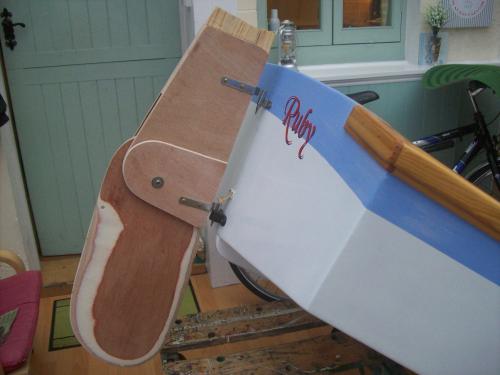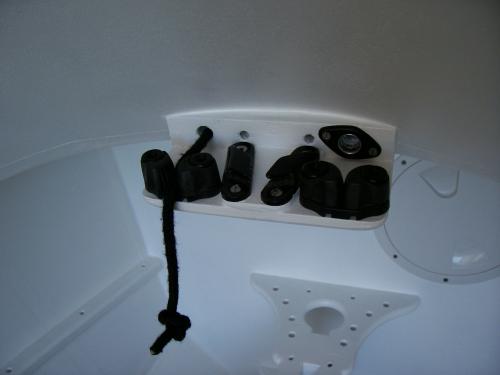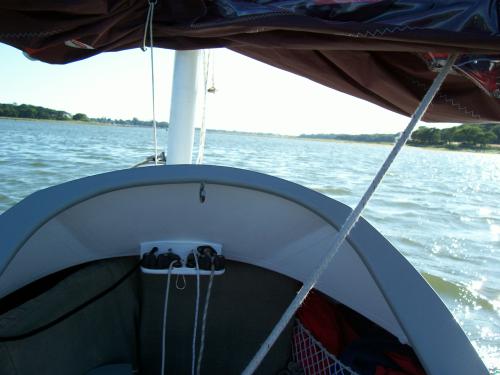This may be obvious but........
|
|
Hello each.
Since my retirement l have used some of my spare time to build my small rowable dinghy which was my first attempt, and l am quite pleased with the final result. I launched it in December and rowed it up and down the Leeds and Liverpool, or at least a very small section of it. I soon got the hang of rowing, something l haven't tried for a long long time. I am now tinkering about with the rudder and dagger board with hopes of getting it sailable for spring. Sailable boat yes, but not me, never sailed in my life, but am willing and hopefully able to learn, which brings me to the first of which l am sure will be annoyingly plenty of beginners queries. Should I use a clamcleat placed in a handy position to secure the halyard, just in case l get into a panic situation and need to drop the sail and apply for he brakes. Or am l already in a panic situation by even thinking this way? Answers on a coast guard please. |
|
|
On a lot of small boats** you can often just let go of the main sheet to take the power off quickly. This is a lot easier than trying to drop the sail, which in a gust will just billow anyway.
You can also just bear away downwind a bit in a bit of a gust, which will take the power off a bit, just be aware that bearing away carries the risk of an accidental gybe if done too vigorously. If you're already close-hauled you can just put her in irons by steering into the wind (don't try this in a gust on a broad reach, though, as the heeling moment will increase a LOT!) Sailing is easy enough to learn, I found. I learned on a big, heavy, massively over-sailed (in terms of sail area) boat, that was racing very competitively, but switched to sailing a very much smaller Sunfish, and it was the smaller Sunfish that taught me a lot more than the bigger boats, mainly because you have to learn to do things in the right order, smoothly and with a modicum of haste. ** The exception is any small boat with a long boom that is rather low, like the Laser or the Sunfish for example. Letting go the main sheet in a gust is a bit fraught in a boat like this, as there's a risk that the tip of the boom will hit the water causing an unwanted, and rather violent and unpleasant, sort of pitch-pole capsize (been there, done that, don't really want to do it again). With boats with a long, low boom, easing the sheet has to be done with caution in a gust, and combined with bearing away downwind (assuming you have the sea room) in order to take the angle of heel off). |

|
Port-Na-Storm |
Re: This may be obvious but........
|
|
Hi Ray,
My very strong advice to you would be to en-role on an RYA beginners sailing course. You could teach yourself, but you'll get there a lot faster and possibly a lot dryer if you are taught. The thing that gets you from consciously incompetent to un-consciously competent is practice, and a bit of theory. Its also the thing which will mean you don't panic, so won't be in the position where you want to dump the rig in the first place, just ease the sheet and point her up a bit until she quietly comes to a stop, head to wind. In my ever so humble opinion, camcleats are fine for jib sheets etc. where it doesn't matter too much when the line pops out unexpectedly but not for halyards etc. where it does. For a boat your size I would think a simple horn cleat would suffice. Have fun. Graham. |
|
|
In reply to this post by Nesting Ray.
Hi Ray.
I'll second Graham in suggesting a simple horn cleat is what you need in a small boat for the halyard. If you are worried about letting it go quickly, don't put a 'locking turn' or twisted loop on, just a few turns around the cleat figure of eight style and it will generally hold up as long as you want it to. You can lock it off for a long passage when you are more experienced. A word of warning though, I got myself into serious trouble once when a home-made carved teak cleat broke and let the halyard go in a rush while I was having fun with an offshore near gale. I panicked when I realised there was nowhere else on the boat to secure that halyard, and I had to beat into the near gale holding the sail up in one hand! Sheet in my teeth. You might want another cleat for something at any time, so have an extra one available. Ian |

|
Nesting Ray. |
Re: This may be obvious but........
|
|
So it was obvious, but not to me, l shall rule out the clamcleat idea and bow to all your superior wisdom and expedience and I thank you all. I was intending to take a RYA course come spring l think it wise, but as lam preparing the boat for wind power there are things l need to ask. The boat is only 10' in length with an 8'-6" mast holding a36 sq ft standing lug sail with a 6'-3" boom set high. This is not not a racing or round the cape set up l am sure. I just want to drift around aimlessly with my panama hat and glass in hand on a lazy hazy afternoon.
|

|
Nesting Ray. |
Re: This may be obvious but........
|
|
 As explained in last post, not a racer.  The beginnings of a rudder. |
|
|
Looks like you've painted the starboard side and the stern, but not yet the port side
 . Nice looking boat though, well done. . Nice looking boat though, well done.
I assume that the line tied off on the starboard side is the temporary arrangement for the halyard? The angle it's running at seems to have put a bit of curve into the mast, but that might just be the lens on the camera. As you undoubtedly know, the halyard needs to come straight down and be attached near the bottom of the mast. Your choice now is to mount the cleat on the mast at the bottom, which is the arrangement I use on my 10' dinghy, or make some cleat arrangement where the mast passes through the gate on the foredeck. If mounted to the foredeck, it will put considerable upward strain on the deck, and also downward pressure on the mast step, both bad for a lightly built plywood boat. Where is the boom downhaul attached? Similar considerations apply to that as well. In my boat, after a capsize I can simply pull the mast out of it's square, tapered hole if I need to, to get the boat upright again. This is a great help in strong or blustery conditions when such a small boat will NOT remain head to wind long enough to right it, when there's a sail flapping around. The mast and sail remain attached through the main sheet, and cannot be lost, and once upright and bailed out I can recover the rig and put it back together in a controlled way. I have a cleat to starboard for the halyard, and one to port for the downhaul, both screwed to my solid Douglas Fir mast. At the time of my mishap, I only had a hook for the downhaul, which could not be used for the halyard. I now use two galvanised steel horn cleats from the local hardware shop (think washing line?). I'm confident these will never break, and if the 2 inch screws pull out of the wooden mast, there must be a hurricane blowing. Good luck with the rig. Ian |
|
|
Nice boat ,as others have said......
Regarding RYA 1 and 2 - I took these courses in 2008 (thanks to redundancy and early retirement ! ),not having sailed for 35 years -although very active canoeing and kayaking . Made the mistake of doing RYA 1 in a singlehander - in laser picos . Hell on my hips . Switched to a double hander for RYA 2 - laser stratos -fantastic . Plus instructor in boat with you. I should have paid the extra ,and done RYA 1 in the doublehander too , for the comfort factor . |

|
Nesting Ray. |
Re: This may be obvious but........
|
|
Thanks for that Ian, yes must get around to finishing the paint job. The photo shows the boat temporarily rigged, l was trying out the mast and sail from a small dinghy that l bought cheap on eBay. The mast has a cleat for the halyard at the bottom which l shall now be using, and will now be taking everyone's advice in letting the sail into the wind for my panicky moments. As for the capsizing, although it may be inevitable l really don't fancy it much at my time of life, but will make provisions for it. Good advice for the double handed tutoring Andre, l will remember that when the time comes, oh my poor knees don't know what's coming to them.
|

|
Chris Waite |
Re: This may be obvious but........
|
|
I see a little mis-com-widgeteration here
A 'Clamcleat' is the trade-name for a single piece of plastic or alloy in the form of a slant-ribbed 'V' groove that encourages the line it is gripping to nestle deeper into its maw, where the hold becomes ever tighter. A 'cam' cleat on the other hand consists of a pair of opposing sprung cams with ridges on their working surfaces that again grip the rope as they put pressure on it, pulling the cams toward each other - again further increasing the grip. I would not use a Clamcleat for any serious halyard, particularly a single mainsail; though it seems reasonable for a light headsail. Too much tension can make these very difficult to release in an emergency and they even have a version that is on a separate baseplate with a quick release catch that allows the cleat to tip in the direction of pull, releasing the rope, to overcome such a problem. I use a cam cleat for the main (and only) halyard on 'Polly Wee' -   It is to starboard here, the other lines are a cam-cleated (black) outhaul to port, taking mooring and anchor lines to the stem-head which I cannot reach from the cockpit, the double topping lift, on a side-opening Clamcleat (port) and the boom downhaul (starboard) also on a side-opening Clamcleat. Similarly, I do cam cleat my mainsheet, as I do not hold with grasping a straining line for hours on end -  And much capsizing it has caused me in unguarded moments. Even this last weekend in the lightest of airs, a spiteful zephyr caught me water-ballast-less and daydreaming, with one foot jammed in some awkward corner and it wasn't until I threw myself over the windward rail and was reduced to inspecting the centreplate that she came back up. Thank heavens for side-decks. NOVICES SHOULD NEVER CLEAT A MAINSHEET I have yet to suffer the failure of a Clamcleat; a cam cleat however, does wear out, the ridges become mere undulations and the springs eventually seize and snap. It is possible to get another device these days, called a (rope, or halyard) 'clutch'; previously reserved for larger craft they are fearfully expensive to my mind. I agree the simplest and most predictable is the stag-horn cleat, though a belaying pin through the mast thwart is a very ancient and elegant alternative. Incidentally Ray, while your pictures (like Mercutio's soul) are "still but a little way above our heads"; may I mention the creases in the sail, running from the throat (lower front end of the lug-yard) to the back end of the boom? I realize that this was just a trial, but it demonstrates very well insufficient tension in the halyard. When setting a four-sided sail, it should be hoisted until you just start to get creases from the peak (the highest corner) to the front end of the boom. Once there is some wind in the sail, these will blow out, leaving you with a perfectly smooth piece of canvas and nods of approval From old farts like me Christo the W |

|
alopenboat |
Re: This may be obvious but........
|
|
On 10 Feb 2015 at 14:56, Chris Waite [via UK HBBR Foru wrote:
> > > I see a little mis-com-widgeteration here > > A 'Clamcleat' is the trade-name for a single piece of plastic or alloy > in the form of a slant-ribbed 'V' groove that encourages the line it > is gripping to nestle deeper into its maw, where the hold becomes ever > tighter. > > A 'cam' cleat on the other hand consists of a pair of opposing sprung > cams with ridges on their working surfaces that again grip the rope as > they put pressure on it, pulling the cams toward each other - again > further increasing the grip. > > I would not use a Clamcleat for any serious halyard, particularly a > single mainsail; though it seems reasonable for a light headsail. Too > much tension can make these very difficult to release in an emergency Last year, on Little Jim, I changed both my halyard and reefing/downhaul from camcleats to clamcleats and have found them more reliable and easier to operate. With a halyard coming to the foot of a dinghy mast, however, I think, with either of these, the lead of the tail would be in the wrong direction for optimum pull while a simple horned cleat would allow swigging up to a decent tension. -- Sail when you can, row when you must, motor when you have to be at work in the morning. Alastair Law Yeovil, England. <http://www.little.jim.freeuk.com> |

|
simplesimon |
Re: This may be obvious but........
|
|
I used Clamcleats on the Mirror halyards, and used to tension them simply by holding the tail and putting my not-inconsiderable weight on it (pushing downwards). Not a problem! Cleated every time.
 Mind you, you do need the metal Clamcleats, not the plastic ones. I suggest either pre-stretched polyester or better Kevlar/Spectra for the halyards to minimise stretch in service. S |
«
Return to General Discussion
|
1 view|%1 views
| Free forum by Nabble | Edit this page |
